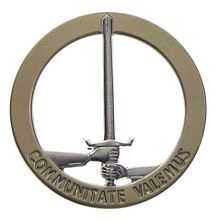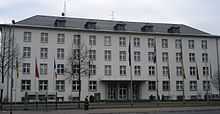I. German/Dutch Corps
| 1 German/Netherlands Corps | |
|---|---|
_Corps.svg.png) | |
| Active | 1995–present |
| Country | Germany, The Netherlands |
| Branch | Army |
| Role | Conventional warfare, peacekeeping operations |
| Size | 30,000[1] |
| HQ/Garrisons | Münster (D), Eibergen (NL), Garderen (NL) |
| Motto |
Communitate valemus Together we are strong |
| Commanders | |
| Corps Commander | Lieutenant General Volker Halbauer |
| Deputy Corps Commander | Major General Michiel van der Laan |
| Chief of Staff | Brigadier General Kees van den Heuvel |
1(GE/NL)Corps is a multinational formation consisting of units from both the Royal Dutch Army and German Army. The corps headquarters also takes part in NATO Response Force readiness rotations. The Corps' headquarters are situated in Münster (Westphalia), formerly the headquarters of the German Army's I. Corps out of which 1 German/Netherlands Corps evolved. The corps has national and multinational operational responsibilities, and its commanding officer is the only one in Europe to have OPCON in peacetime.[2] Due to its role as a NATO High Readiness Forces Headquarters, soldiers from other NATO member states, the United States, Denmark, Norway, Spain, Italy, the United Kingdom amongst others, are also stationed at Münster.
History
In 1991 the defence ministers of The Netherlands and Germany decided to establish a binational unit to replace one German and one Dutch corps. In 1993 a treaty between the two countries was signed which resulted in two previously independent corps being amalgamated to form 1 German/Netherlands Corps or 1 (GE/NL) Corps consisting of one German and one Dutch division.[3]
I German Corps had previously consisted of 1st Panzer Division, 3rd Panzer Division, 7th Panzer Division, 11th Panzergrenadier Division, and 27th Airborne Brigade. After the end of the Cold War, various corps troops, such as Air defense command 1, Pioneer command 1 and Medical command 1 were dissolved in September 1993. For the I Corps Headquarters itself the plans saw first of all that it should be amalgamated in Mönchengladbach with the Territorial Northern Command. However, new considerations to multinational units meant that the German I Corps Headquarters was disbanded in August 1995, being merged into the I German/Netherlands Corps.
The corps' readiness for action was achieved on August 30, 1995 and celebrated in the presence of the Dutch Prime Minister Wim Kok and the German Chancellor Helmut Kohl. The headquarters were chosen to be in Münster because Münster was already the location of the I German Corps' headquarters. For publicity reasons, it was announced that the Münster location was due to the particular significance for both countries as the place where the Peace of Westphalia was signed.
In 1997, Germany and the Netherlands laid down the cooperation in several documents. In general, these state that Germany and the Netherlands provide the Corps framework on an equal basis; both countries share the responsibility for command & control capabilities. In 2002, the Corps met NATO Full Operational Capability criteria and was certified to act as a High Readiness Force Headquarters capable of rapid deployment as part of a NATO Combined Joint Task Force. Since 2002, the multinational Corps HQ has been based on a Memorandum of Understanding between 12 NATO nations. During the deployment to Afghanistan as HQ ISAF between February and August 2003 the Corps executed bi-national command and control for the first time.
The original tasks of the corps lay in the defence of the territories of NATO member states as part of NATO's main defence force as well as taking part in peacekeeping missions, humanitarian missions and emergency aid during natural disasters.

Soon after its readiness for action, the corps was given new tasks: it was designated "Forces Answerable to the Western European Union",[4] and since December 1999, the corps is a Land Component Command within NATO's command structure. At this time its subordinated divisions were the 1st German Panzer Division from Military District Command II in Hannover, and the Netherlands First Division 7 December, a mechanised infantry formation stationed in Apeldoorn, principally its 41st Armoured Brigade, in 1990s 41st Light Brigade?) that had been stationed in Seedorf, Lower Saxony as part of NATO deployments for several decades.[5]
At the same time, the transition to a multinational unit began, which included considerable issues in organisational psychology between the two forces.[6] After concluding exercise "Cannon Cloud" at the Baumholder proving ground in November 2002, the corps became a "High Readiness Forces (Land) Headquarters" (HRF(L) HQ) as part of NATO's Combined Joint Task Force (CJTF). The first deployment within this framework took place between February and August 2003 when the corps operated as ISAF's headquarters in Afghanistan.[7] (HQ ISAF III?)

Following this, the "Land Component Command" was further developed. From the beginning of 2004, the corps was subordinate to NATO Allied Joint Force Command Naples and became "NATO Response Force-Headquarters" (NRF) in November 2004. During the first half of 2005 it was on stand-by as the fourth headquarters (NRF-4) relieving NRF-3, NATO Rapid Deployable Italian Corps (NRDC-IT) at Solbiate Olona. The corps successfully completed exercise "Iron Sword" in June 2005 whereby more than 6,000 troops and 2,500 vehicles were moved from Central Europe to Norway.
Since the transfer of the first Belgian officer in 2005 and ten French Armed Forces officers in 2006 to Münster, twelve nations are represented at 1 German/Netherlands Corps.
From January to July 2005, the Corps assumed the standby role as the NATO Response Force Land Component Command to demonstrate the NATO Initial Operational Capability. During the months of May and June 2005, 1(GE/NL) Corps practiced this capability by conducting exercise IRON SWORD, a challenging Deployment Field Training Exercise to practice multinational operations in an expeditionary environment. In deploying more than 6,000 soldiers and 2,500 vehicles by land, air and sea from Central Europe to Norway, the Corps clearly illustrated the progress made during the NATO Response Force standby period and made a real contribution towards the continual development of the NATO Response Force Full Operational Capability.
The Corps was also the on-call High Readiness Force for NATO contingency operations in 2008. In 2009, the Corps deployed to Afghanistan providing the core staff of the International Security Assistance Force (ISAF) and the ISAF Joint Command. The Corps also provided national troop contributions, most notably a 40 man contingent to Regional Command South.
Currently, apart from its Staff Support Battalion and Command Information Systems Battalion, the Corps does not have assigned units any longer. Following a (NATO) Force Generation Process, the Corps will get multinational units assigned to create a tailor made organisation capable of meeting the given tasks.
Commanders
| Nr. | Name | Country | Start of appointment | End of appointment |
|---|---|---|---|---|
| 8 | Lt Gen Volker Halbauer | Germany | 25 September 2013 | --- |
| 7 | Lt Gen Ton van Loon | Netherlands | 13 April 2010 | 25 September 2013 |
| 6 | Lt Gen Volker Wieker | Germany | 1 July 2008 | 13 April 2010 |
| 5 | Lt Gen Tony van Diepenbrugge | Netherlands | 1 July 2005 | 1 July 2008 |
| 4 | Lt Gen Norbert van Heyst | Germany | 4 July 2002 | 1 July 2005 |
| 3 | Lt Gen Marcel Urlings | Netherlands | 22 March 2000 | 4 July 2002 |
| 2 | Lt Gen Karsten Oltmanns | Germany | 27 November 1997 | 22 March 2000 |
| 1 | Lt Gen Ruurd Reitsma | Netherlands | 30 August 1995 | 27 November 1997 |
Current structure
When not deployed, 1(GE/NL)Corps consists only of administration and logistic support. However, in an emergency the corps must be able to deploy and lead a military mission inside and outside NATO territory within twenty to thirty days.
The previous Commander (COM), as noted above, is the Dutch Lieutenant General Ton van Loon; the Chief of Staff (COS) is the Dutch Brigadier General Kees van den Heuvel. The Deputy Commander (DCOM) is Dutch Major General Michiel van der Laan. Following a three Deputy Chief of Staff structure, since 2013, the Corps is containing 4 entities led by Brigadier Generals, namely the Support Division, the Operations+Training Division, the Knowledge+Policy Production Division and the Communication+Engagement Division.
The following units are permanently part of HQ 1(GE/NL) Corps:
- Staff Support Battalion (Münster)

- Communication and Information Systems (CIS) Battalion (Eibergen and Garderen)
Both these units are fully binational, manned with German and Dutch soldiers.
Notes
- ↑ Cowell, Alan, After 50 Years, a German-Dutch Military Partnership, The New York Times, Tuesday, September 12, 1995
- ↑ pp.26-27, Thomas-Durell Young, Multinational Land Formations and NATO: Reforming practices and structures, Strategic Studies Institute, U.S. Army War College, Carlisle Barracks, PA, 1997
- ↑ p.61, Matláry, Janne Haaland, Østerud, Øyvind, Denationalisation of Defence, Ashgate, 2007
- ↑ pp.28, Thomas-Durell Young, Multinational Land Formations and NATO: Reforming practices and structures, Strategic Studies Institute, U.S. Army War College, Carlisle Barracks, PA, 1997
- ↑ pp.34-35, Fleck, Dieter & Addy, Stuart, The handbook of the law of visiting forces, Oxford University Press (UK), 2001
- ↑ Janssen, Charles J., Dr., Ein bischen "bi" schadet nie: The German-Dutch Army Corps, Psychological & Social Service, 1 (GE/NL) Corps
- ↑ "History of the garrison Münster". Archived from the original on 2008-02-09. Retrieved 2008-02-24.
External links
Coordinates: 51°57′59.40″N 7°36′56.15″E / 51.9665000°N 7.6155972°E